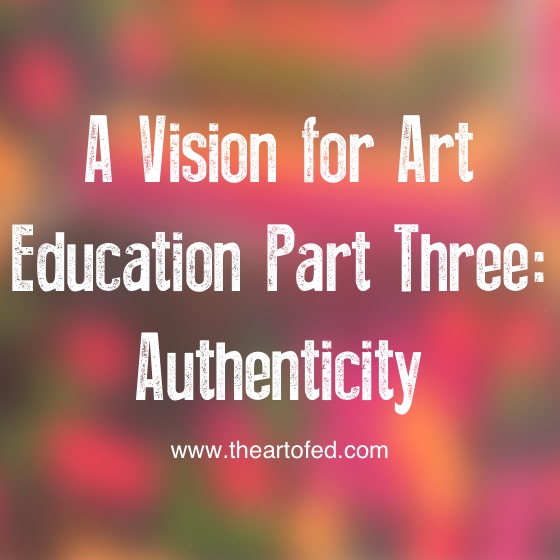
There is a renaissance happening in art education today. It’s a rebirth of concepts and methods that originated as grassroots efforts by art teachers in the 1970s but got overshadowed by the Getty Foundation and Discipline Based Arts Education (DBAE) in the 1980s. Like its beginnings, this renaissance is being led by art teachers who want more for their students than making art through a teacher-directed lesson. They want their students to take part in the full process through making choices, demonstrating their voices and creating authentic art. In short, the vision these teachers have for the future of art education lies not so much in their students making art but rather working as artists.
Authentic Art Making
To be an artist means deciding ‘how’ and ‘why’ a work of art will be created. This, by definition, is the authentic art making process. It is what we as art teachers do when we create art. Having our students create authentic art should be our objective.
In order to meet our objective, there are several areas of control that we need to release to our students. The first area to release is the ‘why’. This is the meaning and purpose the artist defines when making art. It is not uncommon for the traditional art teacher to provide her students with the ‘why’. However, the purpose for the art being created should originate from the artist.
The second area of control to release is the ‘how’. If our goal is to have our students create authentic art, we must provide them the freedom to make decisions about the materials they will use and the way in which they will use them. The traditional art teacher will often decide what materials the students will use for a project. This decision can often be so specific to include the exact size of the paper. We need to relinquish this control and let the students decide what media will best express the purpose of their art.

No Techniques or Lessons?
Relinquishing control over the ‘why’ and ‘how’ does not mean art teachers don’t provide direction or challenge students with limitations. Quite the opposite is true. We certainly need to provide instruction on proper use of materials and techniques and skills. However, we need to make sure these teacher-led lessons are there only as a means to an end. We need to be cautious that our skill-building lessons do not become projects. We should teach skills so students can use them as tools for creating their art.
The Dreaded ‘T’ Word
The renaissance I referred to in my opening sentence is Teaching for Artistic Behaviors or TAB. Some see TAB as the dreaded ‘T’ word. They wrongly misunderstand TAB as being the equivalent of putting out supplies and letting students do what they like. Others equate TAB to full choice. They make remarks such as, “I’m not TAB. I’m modified choice.” TAB is neither of these. TAB is about teaching students to both understand as well as engage in activities as artists. It’s about allowing students to create authentic art.
The future of art education will consist of students making choices about the ‘why’ and ‘how’ in their art making processes. Projects will no longer be extensions of lessons in the elements and principles of art. These will be reduced to mini-lessons to demonstrate techniques as they were originally intended to be taught. A paradigm shift in thinking from product-based projects to process-based thinking will occur. We will no longer be interested in ‘making art’ but rather in ‘making artists’.
How do you make artists in your classroom?
What is the hardest aspect of control for you to give up?
——
As Amanda mentioned on Tuesday, after two years and nearly one hundred articles, I am stepping down as a contributing author for the Art of Education. I have enjoyed working alongside Jessica and the rest of the AOE team. What a wonderful and talented group dedicated to providing Ridiculously Relevant professional development for art teachers!
Likewise, I have enjoyed reading all the comments and email you, the readers, have posted and sent. One of the best aspects of writing for AOE is that it has never been a one-way street but rather an engaging dialogue between art teachers everywhere. I would like to thank everyone for allowing me the opportunity to start those conversations.
M@ke Artists!
Ian Sands
Magazine articles and podcasts are opinions of professional education contributors and do not necessarily represent the position of the Art of Education University (AOEU) or its academic offerings. Contributors use terms in the way they are most often talked about in the scope of their educational experiences.




